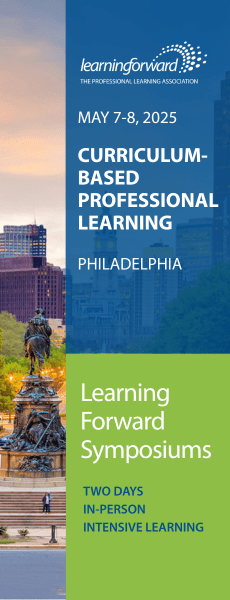FOCUS
We will be different
By Sharron Helmke
Categories: Change management, Coaching, Leadership, Social & emotional learningJune 2020
Vol. 41, No. 3
When we found schools closed in response to the COVID-19 pandemic, many of us wondered, “When are we getting back to normal?” A few weeks later, the question changed to, “Will we get back to normal?” And now, we’re realizing the old normal won’t be back, at least not anytime soon.
Still, we will eventually return to our campuses, students will once again walk through our doors, and in-person schooling will resume. But that doesn’t mean we can pick up where we left off. Things will be different, and it won’t just be because we might be wearing face masks. We will be different.
There are steps we need to take, starting now, to ensure that our staff members have the emotional resources necessary to bounce back, adapt, and thrive in a new environment that has yet to take shape. By focusing on building resiliency now, educators can not only be prepared to navigate a major transition but also to emerge with stronger professional identities and a more connected, committed campus culture.
Acknowledge trauma
The COVID-19 epidemic is happening to all of us, even those of us who aren’t directly impacted by the virus. We are all impacted by the quarantine and the lifestyle changes that it has brought about. Educators are on the front lines of one of those major changes — suddenly taking education online.
We are remote from our students, but also remote from our colleagues, our support staff, and our guiding voices, lacking the frequent face-to-face collaboration that many of us have come to rely on.
We and our staffs have suffered a trauma, and trauma leaves lasting scars that can manifest in surprising ways, even to people you might consider your most reliable, steady, and dedicated professionals.
Research has shown that the stress of trauma isn’t processed through the rational mind, but rather that it triggers more primitive parts of the brain and can create the familiar responses of fight, flight, or freeze — responses we’ve all seen from overtaxed faculty members, even before the latest stressor (Graham, 2013).
Definitions of trauma vary, but one emerging definition stresses that a traumatic event does not have to threaten life, or even health, but rather that it “challenges a person’s ‘assumptive world’: her belief in how people behave, how the world works, and how her life will unfold” (Begley, 2019).
Certainly our assumptions about how school works have been challenged, but for some of us, even more fundamental beliefs may have been challenged: the fundamental nature of what our work is and how (and where) we do it; the personal role that we play in making a difference for students; our relationships to content, educational standards, and pedagogy; and perhaps even to our professional identities as “good” or “successful” teachers.
Build resilience
Fortunately, researchers have shown that it’s possible to foster resilience after trauma — if the environment provides enough support (American Psychological Association, 2020). Resilience is the ability to bounce back from setbacks, including the ability of people to “find a way to change course, emotionally heal, and continue moving toward their goals” in the face of adversity and struggle (Psychology Today, n.d.). Given the challenges and stresses of our jobs as educators, resilience can benefit all of us long after the pandemic has ended.
Researchers have learned that resilience isn’t an inherent character quality that individuals either have or lack. It’s fostered by environmental conditions that help individuals develop internal resources to draw on in times of stress. Hanson and Hanson (2018) group the necessary environmental conditions for developing resilience into three broad categories: safety, satisfaction, and connection.
In the time remaining before we welcome back faculty and students, and in those early months following our return, we can focus attention on ensuring those resources are readily available. In doing so, we increase the likelihood that people will not only bounce back from the disruptions of stay-at-home orders, but also that we’re building resilience against future stress, like the everyday pressures of successfully educating hundreds of students amid ever-increasing demands.
Safety
Obviously, physical safety is important, and it would be wise for districts and administrators to be transparent and direct about health precautions that lower everyone’s risk of catching any illnesses, including the germs that normally circulate through our buildings.
Beyond that, emotional safety depends on a sense of calm despite uncertainty, clarity about what’s going on and what’s expected, and feeling settled. These might sound like simple steps, but in the haste to complete our enormous to-do lists, we can sometimes make choices that inadvertently undermine emotional safety.
Be intentional about maintaining stability. Take care to avoid making changes in the ordinary bell schedule, scheduling unexpected meetings, or requiring sudden changes in procedures or assigned duties unless necessary. Such changes could exacerbate ongoing feelings of stress over uncertainty. In contrast, predictability contributes to feelings of calm and clarity and allows us to reserve our internal resources to meet occasional unexpected challenges as they arise.
As leaders, we would also do well to allow teachers’ choice whenever possible. While this is always a best practice with adult learners, it’s critically important when people feel like much is out of their control. Loss of one’s sense of agency can result in a feeling of helplessness, potentially followed by disengagement and isolation, and possibly even depression or explosions of anger (Hanson & Hanson, 2018). Offering choice (with support) can counteract that loss of agency.
It will also be more important than ever to help individuals feel comfortable to take risks and to be gracious about mistakes that could cause embarrassment to linger. Helping people move past these difficult moments is critical because neurological research has proven that humans have a “negativity bias,” an evolutionary bias for remembering the negative while quickly forgetting the positive (Graham, 2013).
As leaders, we can counter this by paying attention to the positive. Take opportunities to call your staff’s attention to what went well and spend even a bit longer talking about it than you might otherwise, since it takes longer for positive memories to imprint.
Encourage teachers to tell each other about their positive experiences and let the energy from those successes fill the room and be intentional about pointing it out.
In doing so, we aren’t just helping people feel better momentarily. We’re helping to form new connections within their minds — associating challenge with opportunity (Hanson & Hanson, 2018).
Satisfaction
Satisfaction leads to contentment as well as feelings of motivation to keep moving forward. Conversely, a lack of satisfaction can create feelings of frustration, boredom, and disappointment (Hanson & Hanson, 2018). Contrary to the way we usually think about satisfaction, research shows these feelings come not from achieving goals, but from working toward them.
Satisfaction can be enhanced by promoting gratitude, which allows us to step outside of our experience and appreciate our role in something larger than our own challenges (Hanson & Hanson, 2018). Genuine gratitude contributes to a sense of connection and belonging and contributes to feelings of meaning and purpose. It also fosters a sense of feeling good now, rather than waiting for a distant or elusive condition (like returning to “normal”), which can lead to depression, burnout, and a loss of agency.
You can foster gratitude by encouraging teachers to leave words of appreciation on a community gratitude board (either physical or digital) or bringing a stack of thank-you cards to a meeting and giving teachers time to take one and write a message inside.
Another way to encourage feelings of satisfaction is to focus attention on progress rather than outcomes. When we celebrate progress, no matter how small the step, we are encouraging the noticing of positives experiences to offset the brain’s natural tendency to focus on the negative, and we are fostering an increased sense of agency by focusing on short-term goals.
Be sure to set and frequently discuss process goals that address how people wish to conduct themselves in pursuit of the outcome goals. “Whom do we want to be as we stretch for this outcome goal?” is a motivational question that addresses purpose, meaning, and personal fulfillment.
Connection
Schools are communities, and true community is based on a shared set of beliefs rather than a physical location. Those beliefs hold school communities together whether they are scattered throughout a large area or they come together every Monday through Friday in a house of learning.
Now is the time to remind everyone that your staff, faculty, and students will always be a community, no matter what the future holds. Do this by putting the campus or district’s mission statement and beliefs front and center and celebrating them as the foundation of your shared purpose and your guide for daily interactions.
When you return to campus, consider an activity during which teachers are invited to choose one of those shared core values and write a brief account of how he or she enacted or manifested it during the period of remote learning. Consider encouraging students, and even parents, to do the same. Share the stories and ask educators to reflect on all the ways the values were maintained.
Then gather the stories and spend time turning them into one collected story of the campus community’s response to the stay-at-home crisis — a story that says, “This is who we are; this is why it’s important; and this is what it meant for us.” Circulate it to celebrate a shared version of the community’s story and reframe a narrative of crisis, challenge, struggle, and perhaps even loss into a story of resilience, connection, and gratitude for all the ways the community rose to the challenge and displayed their best selves.
A story like this helps the community see the bigger picture, and it instills a sense of order and meaning to replace feelings of chaos and unanswered questions (Barr, 2018; Newman, 2016).
Resilience fosters resilience
These steps are time-consuming but worthwhile, even when so much work needs to be done to make plans for recouping lost instructional ground. If you don’t attend to the emotional well-being of your most valuable resource — your teaching staff — you could end up spending far more time dealing with burnout and staff attrition.
As Hanson and Hanson (2018) note, resilience built now creates future resilience to draw on when needed. These powerful practices will not only speed recovery from the trauma of recent months, they have the potential to make your faculty even more capable of handling the struggles that lie ahead.
References
American Psychological Association. (2020, February 1). Building your resilience. www.apa.org/topics/resilience.
Barr, E.R. (2018, March 1). Lessons in resilience: The stories we tell and why they matter. Daily Good. www.dailygood.org/story/1968/lessons-in-resilience-the-stories-we-tell-and-why-they-matter.
Begley, S. (2019, March 7). The science of bouncing back from trauma. Mindful. www.mindful.org/the-science-of-bouncing-back-from-trauma.
Graham, L. (2013). Bouncing back: Rewiring your brain for maximum resilience and well-being. Novato, CA: New World Library.
Hanson R. & Hanson, F. (2018). Resilient: How to grow an unshakable core of calm, strength, and happiness. New York, NY: Harmony Books.
Newman, K.M. (2016, November 9). Five science-backed strategies to build resilience. Greater Good Magazine. greatergood.berkeley.edu/article/item/five_science_backed_strategies_to_build_resilience.
Psychology Today. (n.d.). Resilience. www.psychologytoday.com/intl/basics/resilience.

Sharron Helmke, senior vice president of professional services at Learning Forward, designs and manages the organization’s consulting service programs that support state, regional, and local organizations in translating their improvement and learning goals into custom-designed high-quality professional learning programs that result in scalable and sustainable change. During her twenty-plus years in education she has served in a variety of roles at the campus and district levels, including teacher, instructional coach, and district-based program administrator. She is an international coaching federation certified professional coach, a Gestalt professional coach, and a trauma-informed care provider, all of which inform her approach to supporting educators. She is the author of numerous professional articles, including “To make a difference for every student, give every new teacher a mentor” in the August 2022 issue of The Learning Journal.
Categories: Change management, Coaching, Leadership, Social & emotional learning
Recent Issues
BUILDING BRIDGES
December 2024
Students benefit when educators bridge the continuum of professional...
CURRICULUM-BASED PROFESSIONAL LEARNING
October 2024
High-quality curriculum requires skilled educators to put it into...
LEARNING TO PIVOT
August 2024
Sometimes new information and situations call for major change. This issue...
GLOBAL PERSPECTIVES
June 2024
What does professional learning look like around the world? This issue...












